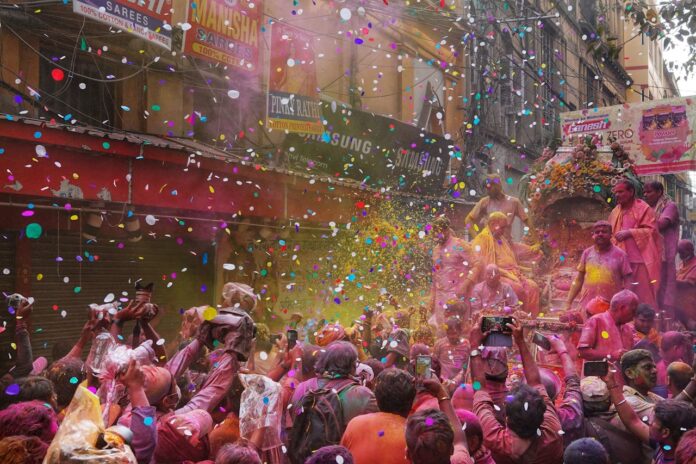
How festivals, food, and film unite cultures through storytelling on screen.
Cinema has always done more than tell stories — it preserves the way we live, eat, celebrate, and dream. Every culture has its signature rhythms, rituals, and flavors, and when these appear on screen, they become a bridge between worlds. A single film can turn an unfamiliar celebration into a shared experience, or make a meal halfway across the world feel like home.
Today, as international audiences grow and regional storytelling becomes global, screens have become cultural gateways. Festivals, foods, and films are a part of the culture that shapes how people understand one another.
The Festival as a Story
Every festival tells a story about where a community comes from. In India, Diwali’s fireworks and lanterns represent the triumph of light over darkness. In Mexico, Día de los Muertos turns remembrance into celebration. In Nigeria, the Calabar Carnival transforms the streets into a kaleidoscope of movement, dance, and costume — a cinematic experience in its own right.
When such traditions are filmed or broadcast, they do more than entertain. They carry emotion, sound, and movement that text alone can’t convey. Television and film let global audiences step into these moments — not as observers, but as guests. Through documentaries, dramas, and live coverage, festivals become living archives of cultural identity.
That’s why regional film and television have become so important in preserving heritage. African TV channels, for example, bring local celebrations, food rituals, and languages to viewers across continents, turning everyday traditions into shared cultural experiences. When such programs stream on platforms like UVOtv, they connect diasporas who might be thousands of miles apart but share the same songs and scents in memory.
The Flavor of Memory
Food on screen is never just about what’s being cooked. It’s about who’s cooking, why, and for whom. In film, a shared meal often represents reconciliation, nostalgia, or love — a universal language of belonging. From Mediterranean kitchen tables to South Asian street stalls, food acts as both a prop and a metaphor.
Cultural theorists often describe cuisine as “edible storytelling.” The way a dish is prepared — slowly, with inherited gestures — mirrors how stories are passed down: carefully, and with memory attached. When filmmakers linger on hands rolling dough, or on the first bite of a childhood favorite, they turn simple actions into cultural testimony.
Television has expanded this even further. Cooking shows, culinary documentaries, and travel programs aren’t just about recipes — they’re about connection. Viewers discover the history behind spices, the rituals of hospitality, and the artistry hidden in daily life. Watching food on screen becomes an act of cultural empathy: we may not taste the same dish, but we feel what it means.
Film as Cultural Translation
If festivals and food are local, film is how they go global. A good story crosses language barriers; a powerful image carries the emotional weight of an entire culture. That’s what makes cinema such an effective translator of identity.
African, Asian, Arab, and Latin American filmmakers have used this power to show the world who they are on their own terms. Their films don’t explain culture — they perform it. From the rhythm of speech to the color of a marketplace, every detail becomes a line of translation. Viewers may not know the folklore behind a festival or the recipe behind a dish, but they understand the joy, loss, and hope that these stories carry.
Streaming platforms have made this exchange even more immediate. A film about a harvest celebration in Senegal, or a street-food documentary set in Mumbai, can reach audiences in Europe or North America within seconds. This is how culture travels now — not through ships and letters, but through pixels and subtitles.
Screens as Cultural Bridges
Global platforms like UVOtv bring together thousands of titles that highlight how communities celebrate, create, and communicate. Independent filmmakers, in particular, use these spaces to keep storytelling close to its roots while reaching audiences far beyond them.
Festivals and food are recurring motifs in these stories because they express what all cultures share: the need to gather, to remember, and to find meaning in the small rituals of everyday life. Whether it’s a kitchen table in Lagos, a wedding dance in Beirut, or a night market in Bangkok, film reminds us that joy, loss, and belonging look remarkably similar everywhere.
A Shared Feast of Stories
When we watch stories from other cultures, we do more than consume content — we participate in an exchange. We learn what celebration looks like elsewhere, and we recognize parts of ourselves within it. That’s the quiet power of film and television: to make distance feel smaller, and difference feel familiar.
Festivals, food, and film all thrive on connection. They are acts of storytelling in motion — one spoken through rhythm, one through flavor, and one through image. And when they come together on screen, they remind us that culture doesn’t stand still; it travels, evolves, and finds new audiences every day.
That’s the beauty of watching the world through cinema — and the reason platforms like UVOtv continue to bring global stories home.
Looking for more festival stories, check out our Hollywood Fringe Festival reviews>>


